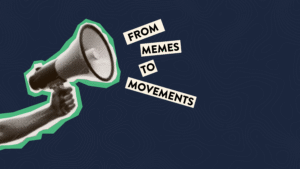If there’s one thing Gen Z is known for, it’s their ability to recognize a faker.
They grew up surrounded by marketing on every platform, from digital ads to influencers and brand campaigns at every scroll. As a result, they have developed what can be called an “authenticity radar.”
That radar doesn’t just detect what is phony. It also picks up on when an organization is trying too hard to appear genuine. For nonprofits and educators hoping to engage younger audiences, this creates both a challenge and an opportunity. Gen Z values honesty, transparency, and purpose more than polish. Winning their trust means showing who you really are, flaws and all.
Why Authenticity Matters More Than Ever
Trust is at a generational low. According to Pew Research Center, “The share of adults who said ‘most people can be trusted’ declined from 46% in 1972 to 34% in 2018… In a 2023–24 Pew Research Center poll, an identical 34% said most people can be trusted.”
This statistic helps explain why Gen Z has developed such strong skepticism toward institutions and traditional marketing. They’re entering adulthood in a world where trust must be earned, not assumed.
For nonprofits and educators, this reality offers a unique advantage. Your missions are already rooted in service, learning, and genuine impact. The key is to communicate those values in a way that feels open, accessible, and real. It’s not necessarily about crafting the perfect message; it’s about sharing a truthful one.
When a student/volunteer/donor sees content that reflects real people doing meaningful work (not just staged photos or corporate-sounding phrasing), it builds credibility and connection.
Show the Process, not Just the Product
Gen Z wants to see behind the scenes. They’re more likely to engage with a cause or program when they understand how it works, who’s behind it, and what challenges they face along the way.
For nonprofits, this might mean showcasing the moments between events, such as volunteers setting up tables or staff preparing materials for the next outreach. For educators, it could mean highlighting the learning process itself: students collaborating, teachers experimenting with new methods, or a candid look at a classroom discussion.
Perfection can feel distant, but progress feels relatable.
Speak Their Language
Communicating with Gen Z doesn’t mean trying to sound like them. It means adopting the tone of honesty and clarity they value most: concise, direct sentences, genuine voices, and minimal jargon.
Visuals matter, too. Photos taken by volunteers or student takeovers often outperform highly produced graphics because they feel genuine. A short video of a teacher sharing why they love what they do can be more powerful than a scripted promo.
Authenticity is the goal, not aesthetic perfection. (You can have both, though; balance is key!)
Own Your Mistakes and Celebrate Growth
Gen Z appreciates organizations that admit when they have room to grow. If your nonprofit missed a goal or had to change course, be honest about it. If your school is learning to adapt to new technology or classroom needs, share that story. Transparency shows humility, and humility reads as human.
As a member of Gen Z myself, I know that when I come across a post that prioritizes transparency, I’m more likely to react positively. This is because it communicates authenticity before performance. That’s something worth paying attention to, especially in a world where genuineness is so rare.
Align Words with Action
At the heart of trust is consistency. Gen Z has grown skeptical of marketing because they have seen too many organizations say one thing and do another. For nonprofits and educators, this means that your message must match your mission.
If you talk about inclusion, show it in your leadership and programs. If you emphasize sustainability, share updates about how you are putting those values into practice. People notice when your actions align with your words, and that is what sustains trust over time.
Authenticity isn’t something you design. It’s something you demonstrate.
The Takeaway
Overall, Gen Z is not hard to reach. They’re just harder to fool. They don’t expect your organization to have all the answers, but they do expect honesty, empathy, and consistency. When you communicate with sincerity, admit what you’re learning, and share stories of real people doing meaningful work, you earn something that no ad can buy: trust.
For nonprofits and educators, that trust is everything. It turns followers into supporters and students into advocates for your mission.
At Dogwood Media Solutions, we help nonprofits, educators, and small businesses tell their stories with clarity and authenticity. Something particularly noteworthy about us is that our staff spans multiple generations (Gen X, Millennial, and Gen Z, to name a few), allowing us to offer input unique to each generation’s experience. This equips us with the perspectives necessary for developing social strategies, creating content, and advertising tailored to diverse audiences.
Reach out to us today for help building communication that feels human, honest, and true to your mission.


